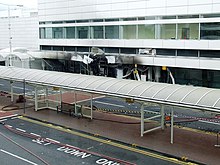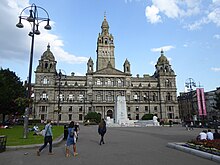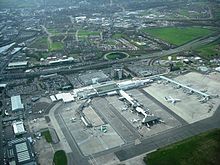Glasgow
In the late 19th and early 20th centuries, Glasgow's population grew rapidly, reaching a peak of 1,127,825 people in 1938 (with a higher density and within a smaller territory than in subsequent decades).
In 1450, John Stewart, the first Lord Provost of Glasgow, left an endowment so that a "St Mungo's Bell" could be made and tolled throughout the city so that the citizens would pray for his soul.
[29] After the Acts of Union in 1707, Scotland gained further access to the vast markets of the new British Empire, and Glasgow became prominent as a hub of international trade to and from the Americas, especially in sugar, tobacco, cotton, and manufactured goods.
The Caledonian Railway rebuilt many of the sewers, as part of a deal to allow them to tunnel under the city, and sewage treatment works were opened at Dalmarnoch in 1894, Dalmuir in 1904 and Shieldhall in 1910.
The works experimented to find better ways to treat sewage, and a number of experimental filters were constructed, until a full activated sludge plant was built between 1962 and 1968 at a cost of £4 million.
[44] The sewerage infrastructure was improved significantly in 2017, with the completion of a tunnel 3.1 mi (5.0 km) long, which provides 20×10^6 imp gal (90 Ml) of storm water storage.
[57] In 2007, the city's primary airport was the target of a terrorist attack when a Jeep Cherokee filled with propane gas cylinders and petrol cans was driven at considerable speed into the entrance of the main terminal building.
Since 2007, when local government elections in Scotland began to use the single transferable vote rather than the first-past-the-post system, the dominance of the Labour Party within the city started to decline.
[13] Glasgow's population influx in the eighteenth and nineteenth centuries was related to economic expansion as well as internally generated growth with the vast majority of newcomers to the city from outside Scotland being from Ireland, especially the north western counties of Donegal, Fermanagh, Tyrone and Londonderry.
This had started as a residential district of the wealthy city merchants involved in international trade and the textile industries in the 18th and early 19th centuries, with their warehouses nearby, including the Tobacco Lords from whom many of the streets take their name.
The area has supported a growth in art galleries, the origins of which can be found in the late 1980s when it attracted artist-led organisations that could afford the cheap rents required to operate in vacant manufacturing or retail spaces.
The West End includes residential areas of Hillhead, Dowanhill, Kelvingrove, Kelvinside, Hyndland, Broomhill, Scotstoun, Jordanhill, Kelvindale, Anniesland and Partick.
The East End Healthy Living Centre (EEHLC) was established in mid-2005 at Crownpoint Road with Lottery Funding and City grants to serve community needs in the area.
[139] To the north of the East End lie the two large gasometers of Provan Gas Works, which stand overlooking Alexandra Park and a major interchange between the M8 and M80 motorways.
The adjoining urban area includes some of Greater Glasgow's most affluent suburban towns, such as Newton Mearns, Clarkston, and Giffnock, all of which are in East Renfrewshire, as well as Thorntonhall in South Lanarkshire.
It was for many years polluted and largely unused after the decline of heavy industry, but recent efforts to regenerate and re-open the canal to navigation have seen it rejuvenated, including art campuses at Port Dundas.
[148] A huge part of the economic life of Glasgow was once located in Springburn, where the Saracen Foundry, engineering works of firms like Charles Tennant and locomotive workshops employed many Glaswegians.
Glasgow has its own "Poet Laureate", a post created in 1999 for Edwin Morgan[153] and occupied by Liz Lochhead from 2005[154] until 2011, when she stood down to take up the position of Scots Makar.
Some of the city's more well-known venues include the Glasgow Royal Concert Hall, The OVO Hydro, the SECC, Glasgow Cathouse, The Art School, King Tut's Wah Wah Hut (where Oasis were spotted and signed by Glaswegian record mogul Alan McGee), the Queen Margaret Union (who have Kurt Cobain's footprint locked in a safe), the Barrowland, a ballroom converted into a live music venue as well as The Garage, which is the largest nightclub in Scotland.
More recent mid-sized venues include ABC, destroyed in the art school fire of 15 June 2018, and the O2 Academy, which play host to a similar range of acts.
The divisions between the two denominations and their respective communities play a major part in sectarianism in Glasgow, in a similar nature to that of Northern Ireland, although not segregated territorially as in Belfast.
[188] Another architect who has had an enduring impact on the city's appearance is Alexander Thomson, with notable examples including the Holmwood House villa, and likewise Sir John James Burnet, awarded the R.I.B.A.
Many of the city's buildings were built with red or blond sandstone, but during the industrial era those colours disappeared under a pervasive black layer of soot and pollutants from the furnaces, until the Clean Air Act was introduced in 1956.
Once dominant export orientated manufacturing industries such as shipbuilding and other heavy engineering have been gradually replaced in importance by more diversified forms of economic activity, although major manufacturing firms continue to be headquartered in the city, such as Aggreko, Weir Group, Clyde Blowers, Howden, Linn Products, Firebrand Games, William Grant & Sons, Whyte and Mackay, The Edrington Group, British Polar Engines and Albion Motors.
[215] Subsequent urban renewal initiatives, such as those motivated by the Bruce Report, entailed the comprehensive demolition of slum tenement areas, the development of new towns on the periphery of the city, and the construction of tower blocks.
[216] Many of Glasgow's worst tenements were refurbished into desirable accommodation in the 1970s and 1980s[216] and the policy of demolition is considered to have destroyed many fine examples of a "universally admired architectural" style.
[231] The world's first international football match was held in 1872 at the West of Scotland Cricket Club's Hamilton Crescent ground in the Partick area of the city.
[237] Glasgow has four professional football clubs, who all play in the SPFL: Celtic, Rangers, Partick Thistle, and Queen's Park (after their move from amateur status in November 2019).
Prior to this, Glasgow had two other professional teams: Clyde (now playing in Hamilton) and Third Lanark (liquidated in 1967), plus four others active in the league in the 19th century: Thistle, Cowlairs, Northern and Linthouse.
Between 1998 and 2004, the Scottish Claymores American football team played some or all of their home games each season at Hampden Park and the venue also hosted World Bowl XI.







































